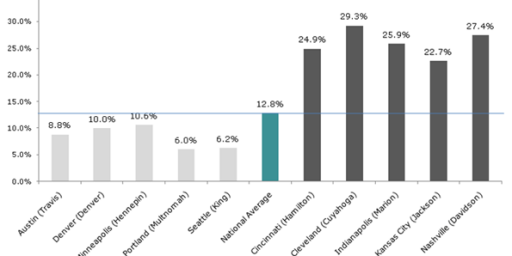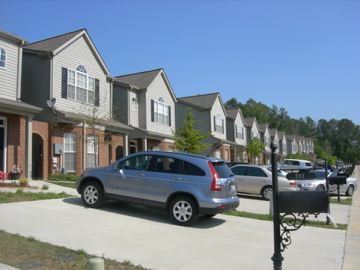America’s Most Walkable Cities Our Best Cities?
The most walkable cities in America are also the most successful.
Richard Florida scans some data on “walkable neighborhoods” and finds that they support his preexisting conclusions.
Either way you slice it, San Francisco tops the list, followed by the East Coast communities of the Bos-Wash corridor: NYC, Boston, Philly, and D.C. Seattle and Portland do well, as does Chicago. Somewhat surprisingly, L.A. scores reasonably highly on both metrics.
[…]
As before, we found significant associations. Walkable metros had higher levels of highly educated people (.44) and of the creative class (.46). Perhaps more significantly, they also had higher incomes (.64) and higher housing values (.55), more high-tech companies (.58), and greater levels of innovation (.4).
Walkability is more than an attractive amenity–it’s a magnet for attracting and retaining the highly innovative businesses and highly skilled people that drive economic growth, raising housing values and generating higher incomes.
While I have no doubt that “walkability” is indeed quite desirable, the idea that this is somehow the driving factor on making America’s largest cities home to high-earning, highly educated people who live in expensive homes is laughable. It’s pretty obvious, in fact, that walkability and population density go hand-in-hand.
Why Great Cities Are Walkable
New York, Boston, Philly, DC, and Chicago were thriving cities well before the invention of the automobile and have remained so from time immemorial. They’ve remained walkable because there’s incredible competition for space, which drives land prices through the roof, and encourages high density living-working-playing areas.
I’m a little bemused at the notion of LA, the nation’s most famous car city, as being “walkable.” But LA is really a series of smallish towns connected by jam-packed highways. Walkability is doubtless part of the appeal of living there but, again, it’s largely a function of high population density and competition for space.
I don’t know Seattle and Portland, the relative new kids on the block, all that well. They’re definitely cities that became what they are today well into the automobile area and have a bohemian, planned community sort of vibe. So they may be legitimate cases of Florida’s “walkability attracts” thesis.
But, for the most part, the variables here are interrelated. A handful of metropolitan areas have a concentration of Creative Class jobs — doctors, lawyers, bankers, financiers, professors, writers, and the like. So, that’s where most people who seek to make their living that way migrate. Those jobs tend to require a high degree of education and to pay well. And, because a whole lot of well paid people want to live as close to their jobs as possible rather than be stuck in traffic several hours a day, they bid up the prices for housing in the central city.
This sets off a spiral that makes “walkability” a must. It’s ridiculously expensive to park a car in these cities, since parking lots and parking garages have to compete with office space and apartment buildings. Oh, and driving is generally slower than walking if your destination is within a mile or two. The combination of the impediments to driving and high population density makes mass transit feasible — further eliminating the need to accommodate driving in city planning.
Why The Heartland Isn’t Walkable
If everyone loves walking so much, why is so much of America unwalkable?
Well, a lot of the country developed an agri-business economy rather than an industrial one. Growing crops or raising livestock requires huge tracts of land with relatively few people. Technology made it less labor intensive and efficient, allowing a tiny number of people to do the work that once occupied most of the population. Over time, it became more efficient to have fewer farms and ranches to achieve economies of scale.
If you employ 200 people to manage 2000 acres of land, there’s probably not going to be a Starbucks nearby.
Oh, and if you’re competing with farm animals and soybean plants for land use, you’re likely to build a one-story house with a three-car garage and a large backyard rather than living in an 800 square feet apartment on the 48th floor of a high rise. Ditto your neighbors — if you have any. And you’ll probably want to hop in your truck to get groceries rather than walking the 23 miles to the Piggly Wiggly.
Why Small Cities and Suburbs Aren’t Walkable
Of course, lots of Americans live in between these extremes, living neither a rural existence nor downtown in a teeming metropolis. There are smaller cities and suburban areas that have limited walkable areas but generally not all that much mixed use land.
Here, public policy decisions have tended to work against walkability. Land is cheap in most of these places, so people naturally build bigger houses. The natural desires for privacy and a desire to live amongst your own kind tends toward communities of single family homes of similar size and cost rather than being stacked atop one another in deluxe apartments in the sky.
For obvious reasons, since these cities were mostly built in an era where people had their own cars, they tended to segregate housing subdivisions from industrial areas, initially through choice and latter through zoning laws. Shopping areas tended to get built just far enough from these housing areas so that most people had to drive to get there. Large parking lots, where people naturally don’t have to pay to do business, further enables driving but also adds to the sprawl with makes it necessary.
Improving Walkability
While walkability is mostly a byproduct of population density and economic base — not, as Florida would have us believe, a key driver of these things — there’s little doubt that we’d be better off with more of it. Long commutes and traffic jams are draining, stressful, and robbing us of time with our family. Driving everywhere is contributing to our national obesity epidemic. And segregating our work, home, shopping, and other activities into widely spread clusters is disconnecting.
There has been a move over the last fifteen or twenty years to move these places in the other direction, whether to revitalize downtown areas or to encourage mixed use development. In some of the newer exurban areas of DC, for example, housing clusters are intentionally interspersed with beautifully bermed strip malls containing shops, restaurants, doctors and dentists offices, and the like. They don’t quite break the driving habit but they at least allow for fewer trips.
But the big city life isn’t for everyone. I enjoy working in DC more than I thought I would but, as much as a hate the traffic — both sitting in it and having to account for it constantly in everyday decisionmaking — I have no desire to move to a tiny townhouse with no backyard. Not having grown up in a big city, I value space, privacy, and quiet too much for that.
And, amusingly, while DC is supposedly one of the very most “walkable” cities in the country, I actually find walking it very aggravating. Having to stand around and wait for a light to change at virtually every intersection is pretty much like being stuck in traffic.







Are you aware of the strong correlation between daily driving distance and obesity?
Do you remember that walkable cities have lower rates of obesity?
Do you remember my recent links showing fewer years of healthy life in America as a result of obesity?
But, let’s rant against walkability.
The car is what made us great. Or at least fat.
(This is another health and common sense thing that has become a red state, blue state, divide. And, I’m afraid you are on the wrong side of it if you are defending what is stupid and unhealthy.)
John,
The post is in no means a rant against walkability. I extol its desirability multiple times, in fact. For example:
I’m merely suggesting that Florida gets the direction of causation wrong: Walkability is a byproduct of a dense concentration of people, not the reason everybody comes.
First of all, Florida talks about they kind of people:
If you are making a claim that those concentrations always come with density, I think you need some independent data.
Secondly, walkability is a new desirability, and “new urban” communities are springing up.
When customers want, and capitalism delivers, it’s hard to think it is (a) accidental, or (b) communist.
The urban areas have always been where the “creative class” gathered.
Part of what Florida argues (see his linked earlier study) is that this trend has only increased in recent years, as the inner cities have gentrified and otherwise made themselves more attractive to these people and the neighboring suburbs have decayed and become the places where those displaced by gentrification moved.
Yes, there’s a “new urban” movement. I refer to it in the last section of the post. But the old urban centers who were first movers — especially NYC, Boston, DC, LA, Chicago, and SanFran — are likely to always be where the bulk of the CC’s live.
The self licking ice cream cone.
Florida thinks he has data that walkable urban centers rank better than non-walkable of similar density. To disprove, you need non-walkable urban centers with higher accomplisher.
The photo says volumes about the inevitable future of city waking!
How long before the walking license, shoe tax and registration takes effect?
Someone must pay for the sidewalks! (lol)
Don’t worry floyd.
“Conservatives, defending your right to be fat and stupid since 19xx”
LA is NOT walkable in the same way that DC or NYC is. SoCal in general was built around the car.
Pop centers that aren’t walkable: Houston leaps to mind. Dalas as well.
None of thus Is to diss walkability, btw.
I haven’t been up to LA in a while, but it was a milestone when people I knew started moving back in, to high-rises. When I was a kid you made the trip down for jobs, or the garment district.
“Conservatives, defending your right to be fat and stupid since 19xx”
No,John, only defending my right to self determination, fat and stupid sounds more like the mandate of liberals, who would, to paraphrase Kipling…
have all men paid for existing and no man pay for his sins.
BTW; consdering the clothing trends should that 19 have a few more Xs?
“BTW; consdering the clothing trends should that 19 have a few more Xs?”
Good one, but that’s rather the point.
My first instinct is very much to trust consumers to do what’s right … but it just isn’t working out too well.
That is, unless you think fat and stupid is a good future.
John Personna: Florida thinks he has data that walkable urban centers rank better than non-walkable of similar density.
Does he control for density? I haven’t seen any reference to that. (I should add here that if are in a city with high density, it’s pretty stupid not to make it as walkable as you can.)
Are you aware of the strong correlation between daily driving distance and obesity?
Perhaps the best way to reduce daily driving distance is for employers to move out to the suburbs.
Ran across an interesting list:
New York City is the worst [in terms of commutes] in the country, as it takes a commuter there an average of 38.4 minutes to get to work. Chicago ranks No. 2 in average travel time at 32.7 minutes, followed by Philadelphia (30.3 minutes), Riverside, Calif. (29.8), Baltimore, Md. (29.7), Washington, D.C. (29.4), San Francisco (29.2), Oakland (29.1), Los Angeles (28.5) and Boston (28.2).
Does this list look familiar? Walkability does not seem to help driver commute times and may even hurt it. Even in a lot of these “walkable” cities, most people are still driving. The driving is just typically more difficult.
Pop centers that aren’t walkable: Houston leaps to mind. Dallas as well.
According to the second list, Houston is above-average in terms of walkability. Austin is even in the top 15 (of the 40 listed). Both are slightly (low 20’s) on the first list.
Sorry, the above “an interesting list” was supposed to link here.
“My first instinct is very much to trust consumers to do what’s right … but it just isn’t working out too well.”
So you, in your infinite wisdom are going to tell them what to do, for their own good, of course.
Stupid freedom, so overrated.
“So you, in your infinite wisdom are going to tell them what to do, for their own good, of course.
Stupid freedom, so overrated.”
I can’t remember a nanny law that I’ve actually supported(*), but as I say, I’m not happy with the outcome.
I mean, when your political economy is rooted in the idea of rationally self-interested individuals, and you discover people aren’t really like that, what do you do?
It is perhaps dream vs reality.
* – oh, I think taxes on booze and cigarettes are fine, and the best argument for a soft drink tax is that it’s in that mold.
You know, there are areas where liberals get human nature wrong. We are not as selfless as socialism requires. We are not so peaceful that unilateral disarmament is a sensible idea. And on and on.
On the other hand, they are right that we as a nation are not taking care of ourselves.
We are living less years in good health.
So what is the solution from the right, one to deal with that reality?
Not sure what the solution on the right is. The libertarian solution is to let the chips fall as they may.
People choosing to eat, drink, and be merry for decades at the cost of one fewer lousy year at the end isn’t entirely irrational. There’s something to be said for asceticism, but it’s not for everyone.
Not sure what the solution on the right is. The libertarian solution is to let the chips fall as they may.
Stopping corn subsidies is typically on the agenda, though they also want to open up sugar trade, so that’s probably a wash.
oh, I think taxes on booze and cigarettes are fine, and the best argument for a soft drink tax is that it’s in that mold.
My main problem with booze and cigarette taxes are their regressive nature, but that’s not enough for me to oppose them. Soft drink taxes are a bit more problematic because you have a spectrum of drinks ranging from soft drinks to artificial fruit juice to cranberry juice to orange juice. You would likely need to make it a “sugar-added tax”, which is harder to sell. That’s leaving aside the studies suggesting that artificial sweetener has its own pernicious effects.
JJ — I understand the libertarian’s desire to “let the chips fall where they may.” But this entire formulation of consumers following their own desires versus nanny state governments who want to tell them what to do completely ignores the billions of dollars spent every year by corporations that sell products that damage us.
Yes, I understand we have free will and are under no obligation to buy Cheetohs. But that seems to be the entirety of the libertarian answer. If the government puts out counter-information, that’s socialism. If the government tries to pass laws limiting what can be sold, that’s fascism. (According to some Republicans, it’s evil and corrupt of the government to try to stop companies from selling eggs they know are contaminated with salmonella.)
So we have our free will to choose between, say, Cheetohs and not-Cheetohs. And on the Cheetoh side we’ve got millions of dollars spent seducing into buying. And on the other side? Is anyone allowed to give the reasons why a Cheetoh and Pepsi diet is not ideal? And if so, who? And if it’s anyone but the government, who exactly has the money and power that even approximates what the sellers are spending to sell?
Does being a libertarian mean we must all be at the mercy of anyone with more money? Or is it ever permissable for the people to come together and work as a society to address a problem?
It’s not a year for affected individuals. That’s the change in expectancy, so far, across us all.
Given that the younger cohort is heavier, it bodes further declines.
I don’t have objection to teaching about nutrition in school. They did in my day. Although, come to think of it, grade school teachers are much fatter these days.
The walk from the ferry building to AT&T Park for a Giants game is a true pleasure. Take a train from the east bay right to the Embarcadero. Walking around SF never gets old. It’s a pretty sucky place to drive and park..
> People choosing to eat, drink, and be merry for decades at the cost of one fewer lousy year at the end isn’t entirely irrational.
Yea, but raising a generation of morbidly obese children probably is.
>”Does being a libertarian mean we must all be at the mercy of anyone with more money? Or is it ever permissable for the people to come together and work as a society to address a problem?”
wr, I think we already know the answer to your quations.
“My first instinct is very much to trust consumers to do what’s right … but it just isn’t working out too well. That is, unless you think fat and stupid is a good future.”
“””””””””””””””””””””””””””””””””””””””””””””””””””””””””””””
John Personna;
Actually I don’t think that “fat and stupid” is a good future, but I do think it is the policies of the left that have resulted in a “fat and stupid” population to the degree that it is.
While some need and deserve government assistance, wretched excess has proven to be a disservice to those who might otherwise have learned to fend for themselves, which would have made them “thinner and smarter”. As some clever person once wrote……
IT’S A SAFETY NET, NOT A HAMMOCK!
BTW, Your civility and willingness to speak only your own mind is appreciated.
John personna;
It occurred to me that you may not know that my reference to the photo was the basis of my first comment. The photo itself is of John Cleese from his “Bureau of Silly Walks” which is itself social commentary on the wretched excesses of government. Thus…
“The photo says volumes about the inevitable future of city waking!
How long before the walking license, shoe tax and registration takes effect?”
Is merely an extension of the Monty Python skit which was finally canceled having reached a point in history in which it was no longer possible to parody government excess.
I guess I failed to recognize the foolishness of my effort?(LOL)
Of course, that skit, and everything else in Monty Python’s Flying Circus was paid for by… the British government, through the BBC. Does that make Monty Python evil too?
Well, for whatever reason, no American city can compare to any European city for walkability.
Wr;
Evil is your word and projection bias is a common malady here.
The wretched excess of the British government brought on our revolution and ultimately their demise as a world power….. Are we next, or is that an inquiry too late in coming.
Gerry W;
Tucson Arizona would be an example of a city which largely came to maturity after the automobile. Most European cities were walkable long before there was a viable second choice. If your observation is valid, which seems reasonable, then that may be a factor.
Nice to see you are a Monty Python fan Floyd. Here is John Cleese on the goddess of the right, Sarah Palin:
http://www.youtube.com/watch?v=blesmzddd38
Floyd – more Cleese here. I find it interesting that you would refer to Monty Python in a political conversation. You must know how much Cleese loathes pretty much everything you believe in. Or perhaps you don’t…
http://www.youtube.com/watch?annotation_id=annotation_876977&v=BIz4KrZottM&feature=iv
anjin-san;
First, as usual you presume too much. This is especially true if you as wrong about Cleese as you are perenenially about me.
Second, I made no reference to Cleese’s politics, only to a skit in which he participated .
Since I am sure you know even less about Cleese than you do about me you hardly have standing to comment on our common ground.
Third, Making a Monty Python reference doesn’t make me a fan, being a Monty-Python fan wouldn’t make me a Cleese fan, being a fan of Cleese’s work would not make me a fan of his politics.
If jumping to conclusions were a real athletic event, you would certainly be podium material.
Fourth, You and I seem to disagree occasionally and I still love you.
Yes, but are you a fan?
Anjin-san;
I listened to Cleese’s interview and found nothing offensive about it, in fact his parrot analogy pretty much applies to 75% of all the politicians I have met or with who’s carreer I have become aquainted .
I have friends who, like you, do not see that this is true of resident B.O. Their bias doesn’t prevent our friendship.
What do you think of Palin’s presidential aspirations? If nil, then why the fascination?
If sheer intellect and experience could win the presidency, then Keyes would be there now and Gingrich would likely be next, at least considering the present field.
But you and I both know those are not the qualifications.
“”Yes, but are you a fan?””
“”””””””””””””””””””””””””””””””””
Anjin-san;
Of yours? Not particularly, I must admit.
Perhaps if you were more cordial……
Actually, I meant Cleese.
In real life, I am a very cordial person. My online writing style tends to be pretty terse, mostly due to time limitations and the fact I get sarcastic when politics are on the table.
> I listened to Cleese’s interview and found nothing offensive about it
It’s not offensive at all. It is witty, articulate and informed. It also makes it clear that Cleese thinks Palin is a joke, and her supporters along with her. Other Cleese comments show he felt the same way about Bush, and that he greatly admires Obama. I have seen a number of folks on the right citing Monty Python to support their political arguments. Given Cleese’s stated views, I am not going to let that go unchallenged.
> What do you think of Palin’s presidential aspirations?
She is clearly a force to be reckoned with. And she has the potential to be even more destructive than Bush, which is truly scary.
Anjin-san;
I “hired” John Cleese as court jester, not as political advisor.
I do understand why the left would seek the council of clowns.
Do you honestly challenge the contention that the “Bureau of Silly Walks”skit was meant to lampoon excessive government bureacracy?’ If so then you have merely proven my theory of the demise of the “Flying Circus”
Floyd — If you’re not yet aware that the British government from which the US declared its independance is different from the one that funded the BBC in the early ’70s — if you’re not aware, as you seem not to be, that the monarchy of the 17th century has been replaced as a governing force by a representative democracy and that while there still is a royal family they are strictly decorative — you should really try picking up a book sometime. It’s a fascinating story.
Oh, but not a book by Glenn Beck.
“Well, for whatever reason, no American city can compare to any European city for walkability.”
You do realize that this is due more to a lower standard of living for the popluation than any other reason, don’t you? It is more a matter of necessity than choice.
I think it is the way cities are structured. We have urban sprawl and more land to do it with. In Europe every space is used creating higher density. Many sidewalks are 5 to 10 feet wide and even allows for bicycle lanes. In the U.S. you need a car for just about every activity. Not so in Europe. Public transportation is abundant and cities are more compact.
Wr;
Pickup a book or two yourself, our revolution was nearly a hundred years after the century that you cited and nearly a century after royalty ascended by an act of Parliament.
Sure the system has changed,and power has shifted, but it was roughly modern at the time of our revolution.
Many will argue that we still have the same form of govenment that we had in the early 19th century. It is certainly as true of Great Britain, as it is of the U.S.
The admontion is valid and stands. Wretched excess is wretched excess.
> I “hired” John Cleese as court jester, not as political advisor.
So you don’t know that there is a difference between being a brilliant humorist and a clown? Ok, will explain it you. A brilliant humorist might well turn out to be an astute political advisor and observer as well. A clown is just a clown (see “Glenn Beck”, if you need an example about the clown thing).
No clown is just a clown,
just think of that greatly talented one who used to perform in Illinois!
> No clown is just a clown,
Well, we have to admire your self-awareness…
Anjin -san;
I see that you presumed to explain something you have no knowlege of.
The reference was to BOZO the Clown who entertained millions for years.
Thank you anyway for the compliment, I would have thought that you were the only object of your admiration, for that I must apologize.